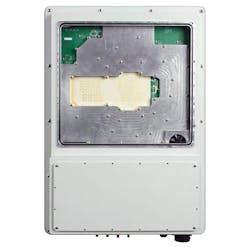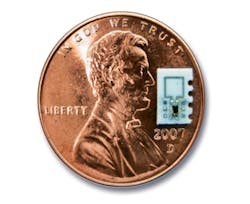This file type includes high resolution graphics and schematics.
Wireless technology was once synonymous with cellular communications and the portable telephone. But just as cellular networks and cell phones have evolved over the years, so too have the myriad applications for wireless technologies, with wireless connections being made from the shortest distances to the highest frequencies. Wireless equipment suppliers are now faced with requirements that can essentially include frequencies from DC through the millimeter-wave range, with communications distances ranging from less than an inch to back and forth between satellites. Over the next decade, it appears that wireless technology will only continue to expand into a variety of different markets, including commercial, industrial, military, and even medical applications.
Related Articles
• Wireless Charging Graduates To Tabletop
• Two 2014 Vehicles Join Qi Wireless-Charging Parade
• Phased-Array Antennas Aid Wireless Communications
Cellular communications systems are in the thick of ongoing buildups based on fourth-generation (4G) Long-Term-Evolution (LTE) equipment and technology. Nevertheless, such companies as Intel Corp. are already promoting the expected capabilities of fifth-generation (5G) cellular networks, even if those networks are not expected until 2020 or later. As the use and ownership of mobile/wireless devices such as smartphones, iPads, and laptop computer continues to increase, the demands for wireless network bandwidth grow, as the available bandwidth is quickly consumed by voice traffic, wireless data, and wireless video communications.
Service providers working with 4G LTE capabilities are exploring the benefits of smaller cell sites and what are being known as heterogeneous networks (HetNets). These are combinations of Wi-Fi stations, cell towers, and smaller cell sites—even, in some cases, wireless base stations located within homes. (See “Building Base Stations For Use In Homes.”)
Intel’s interest in 5G wireless networks is quite logical, given the number of opportunities for the company’s microprocessor chips represented by 5G products. Intel has claimed to have invested at least $3 million so far in support of wireless research towards 5G technologies at more than 10 universities, including Cornell, Princeton, Stanford, the University of Illinois at Urbana-Champaign, and the University of Texas at Austin. Intel is also working in partnership with Verizon on wireless research for 5G, under the auspices of Intel Labs and the recently formed Intel Strategic Research Alliance (ISRA).
Another company with strong belief in the potential for 5G cellular communications, Samsung, has already prototyped portable wireless devices working at 28 GHz. The firm has demonstrated error-free data rates to 256 Mb/s and data rates with minimal error to as high as 512 Mb/s (Fig. 1). These data rates are considerably higher than the theoretical maximum of 75 Mb/s possible with 4G LTE technology, and Samsung claims that its wireless technology can support data rates in excess of 1 Gb/s over distances to 2 km. The well-known tradeoff for such high-frequency signals is high atmospheric attenuation and limited transmission range, along with difficulties in maintaining connections with moving receivers (see “Take The Train To The Internet”), although these prototype tests have been demonstrated over distances as great as 200 m without line of sight and with moving transmitters and receivers.
1. Prototype devices working at 28 GHz are designed to increase the data rates of next-generation wireless cellular systems. (Photo courtesy of Samsung.)
Samsung’s technology, which is sometimes referred to as “millimeter-wave cellular” communications, involves sophisticated beam-forming techniques: Some 64 antennas are used in both the transmitter and receiver, with rapid switching among the antennas. The antennas are switched in a matter of milliseconds as a handset moves, so as to acquire the best signal for the environmental conditions (such as reflections from walls). Of course, one of the challenges inherent to this unique technology approach is finding some means of fitting 64 antennas into a mobile wireless device.
An emerging, rapidly growing segment of wireless technology is in the area of near-field-communications (NFC) applications. This is essentially the use of wireless technology to exchange different types of information—such as telephone numbers, personal files, or payment information—across a short distance, as between mobile telephones or other wireless devices. The technology is centered on the 13.56-MHz frequency of radio-frequency-identification (RFID) devices and data rates to about 424 kb/s at distances to a few inches. The technology is supported by the NFC Forum, a non-profit industry association started in 2004 by Nokia, NXP, and Sony; members include Verizon Wireless and Discover Financial Services LLC.
This file type includes high resolution graphics and schematics.
Curing Ills
This file type includes high resolution graphics and schematics.
Wireless technology is expected to expand significantly into medical areas for a number of different applications. These include remote monitoring of patients, fast access of medical data for medical professionals, and tracking dementia patients by means of Global-Positioning-System (GPS) devices. Combining wireless communications with the growing number of sensors used for health applications—such as for monitoring heart rate, blood oxygen levels, and blood sugar levels—makes it possible for a doctor to remotely check on a patient and even trigger a medical response from a distance if necessary.
Related Articles
• Wireless Charging Graduates To Tabletop
• Two 2014 Vehicles Join Qi Wireless-Charging Parade
• Phased-Array Antennas Aid Wireless Communications
Some of the growing number of wireless solutions for healthcare applications are expected to fall under the category of “machine-to-machine” (M2M) applications. These are applications in which remote sensors may be communicating via the Internet and with wireless technologies with automated monitoring stations, alerting a medical professional when some action must be taken.
Research being performed as part of the WISERBAN project seeks to improve the state of electronic body implants (such as pacemakers) with improved communications capabilities, lower power consumption, and reduced size. The project is focused on the miniaturization of wireless body-area-network (WBAN) devices, applying a number of different technologies, including RF/microwave and microelectromechanical-systems (MEMS) devices. So far, the organization has succeeded in combining these technologies into the fabrication of a low-power radio measuring just 4 x 4 x 1 mm. It combines MEMS and CMOS integrated-circuit (IC) technologies to save size and power.
In the United States, the Federal Communications Commission (FCC) has already set aside spectrum in the band from 2.36 to 2.40 GHz for the use of WBAN devices. By employing such devices in hospitals, clinics, and doctors’ offices, the hope is to eliminate the clutter of cables currently used to operate electronic devices for patient monitoring, as well as to improve the efficiency of communications among the different electronic medical devices.
For their part, WISERBAN, in addition to refining software in support of these WBAN devices, has developed system-on-chip (SoC) devices that integrate MEMS devices, radio circuitry, and digital-signal-processing (DSP) circuitry on a single silicon die. WISERBAN has also tackled an important component of any medical wireless solution—the antenna—and created miniature antenna prototypes capable of covering the entire 2.4-GHz frequency band. The organization has also developed and optimized a dedicated protocol stack for low-power communication with body-sensor networks. The WISERBAN project is coordinated by the Centre Suisse d’Electronique et de Microtechnique (CSEM) in Neuchatel, Switzerland.
Stanford University has also been active in researching emerging wireless technologies for healthcare applications. Stanford Assistant Professor Ada Poon has developed self-propelled, wirelessly powered medical devices capable of controlled motion through blood and other bodily fluids. The medical devices can be implanted or injected into the human body and powered wirelessly, by means of an applied electromagnetic (EM) field. These devices could potentially be used to travel through the bloodstream to deliver drugs, provide analyses, remove plaque from arteries, and even perform minimally invasive surgeries.
2. Implantable in-body medical devices draw power from external EM fields operating at about 1 GHz. (Photo courtesy of Stanford University.)
Implantable medical devices have traditionally been challenged by their need for power, from batteries, which limited how small the devices could be made. These new devices draw power from an EM field and can be made extremely small without batteries (Fig. 2). Poon’s work required a rethinking of how human tissue responds to EM energy, with her modeling tissue as a low-loss dielectric material. She was able to use a higher frequency, at 1 GHz, for powering the implanted devices, and use smaller antennas for those devices. Research on these tiny medical devices was made possible by the support of C2S2 Focus Center, Olympus Corp., and Taiwan Semiconductor Manufacturing Co. (TSMC).
This file type includes high resolution graphics and schematics.
About the Author
Jack Browne
Technical Contributor
Jack Browne, Technical Contributor, has worked in technical publishing for over 30 years. He managed the content and production of three technical journals while at the American Institute of Physics, including Medical Physics and the Journal of Vacuum Science & Technology. He has been a Publisher and Editor for Penton Media, started the firm’s Wireless Symposium & Exhibition trade show in 1993, and currently serves as Technical Contributor for that company's Microwaves & RF magazine. Browne, who holds a BS in Mathematics from City College of New York and BA degrees in English and Philosophy from Fordham University, is a member of the IEEE.



